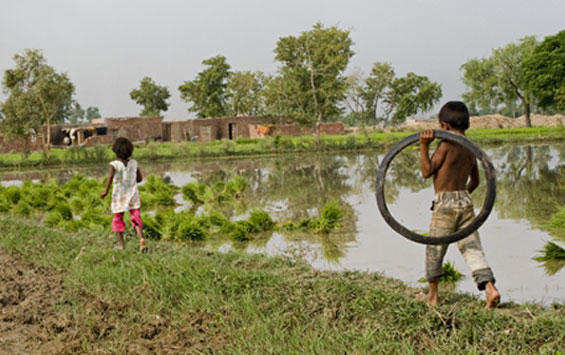|
 By Estella Hung By Estella Hung
In one image a mother wearing headphones breastfeeds her child sometime during the last decade. In another, a group of fakirs poses in regal surrounds sometime in the 1890s. In still another, a lone woman, her head bound in a khemar, stares penetratingly out amid waving flags of the Pakistan Muslim League during a protest against the newspaper cartoons of the prophet Muhammad in 2005.
Such is the range and ambition of Where Three Dreams Cross, an exhaustive survey of some 150 years of photography from India, Pakistan and Bangladesh. As it spans the last chapter of British India up to the present day, the exhibition gives us a strong sense of what happened when natives seized that most colonial of gadgets – the camera – and ran with it.
What we get is an eruption of contrasts befitting a geographical area of unrivalled diversity. The formal is presented alongside the informal, the ordinary is pitted against the extraordinary, the intimate runs counter to the inscrutable. All the while, these contrasts betray the evolving practices of South Asian photography: amateur street photography, photojournalism, fine art photography, digital photography.
Where Three Dreams Cross is sorted into themes – The Portrait, The Performance, The Family, The Streets, The Body Politic – some of them overlapping. This categorisation helps chronicle more effectively the changes in how subjects are treated by photographers over time than if the exhibition were organised chronologically or along country lines. As its title suggests, the retrospective is meant to respect the three countries’ shared pedigree as well as their parallel developments in photography (although Bangladesh seems to have raced ahead).
The exhibition begins with The Portrait. Portraiture was initially the preserve of the Indian aristocracy, and we find many portraits from the 1890s and early 1900s of the blue-blooded and well-endowed, some of them touched up garishly with watercolour to suggest the kind of otherworldliness associated with their subjects.
The Portrait then migrates from the studio to the street, supplementing its role in expressing status with a power to probe the minds and conditions of its subjects. In the case of Dileep Prakash’s photo-essay on the mixed-raced, for instance, the viewer is spurred into considering the confluence of events that made Prakash’s subjects particularly distinctive.
The western conception of the subcontinent as a teeming maelstrom of humanity divided along class and religious lines is largely absent here. In The Body Politic, a section one would expect to contain some gripping political reportage, we instead get Bangladeshi photographer Munem Wasif’s emotive image of a bedraggled old man, one hand against his eye, foregrounding what appears to be the scorched earth effect of climate change on Bangladesh.
In another, Wasif evokes pathos with his grainy shot of illegal migrants from Myanmar scurrying away amid a mountain of vegetation. While such rare documentation deserves our appreciation, the efforts of the curators to shirk cliché seem to unduly paper over the subcontinent’s vital and often troubled political history.
Of course, the avoidance of cliché can be profoundly illuminating. In The Performance, I was inclined to skip the mid-century film stills of Bollywood stars and head straight for Saibal Das’ quaint but goading behind-the-scenes photographs of Indian circus performers, as well as Pushpamala N’s portraits of herself striking poses that appear to be refracted through Hollywood film noir and Indian legend.
Meanwhile, in The Family, Pakistani photographer Nony Singh’s photographs of her family beguile with their blend of charm and intimacy, stylishness and informality. But what really caught my eye was conceptual artist Vivan Sundaram’s reconfiguration of a shot of painter and relative Amrita Sher-Gill lying topless near a windmill. Its stylised, semi-erotic nature brings it close to something Helmut Newton would produce, yet its postmodern construction in many ways subverts the great fashion photographer.
If good exhibitions can simultaneously challenge and entertain, then Where Three Dreams Cross is of the first order, for it is likely to leave even those who think they know a thing or two about South Asian photography overwhelmed, dumbfounded and just a little bit bemused. So do make a day of it.
Where Three Dreams Cross is showing at the Whitechapel Gallery in London until April 11 |






 By Estella Hung
By Estella Hung